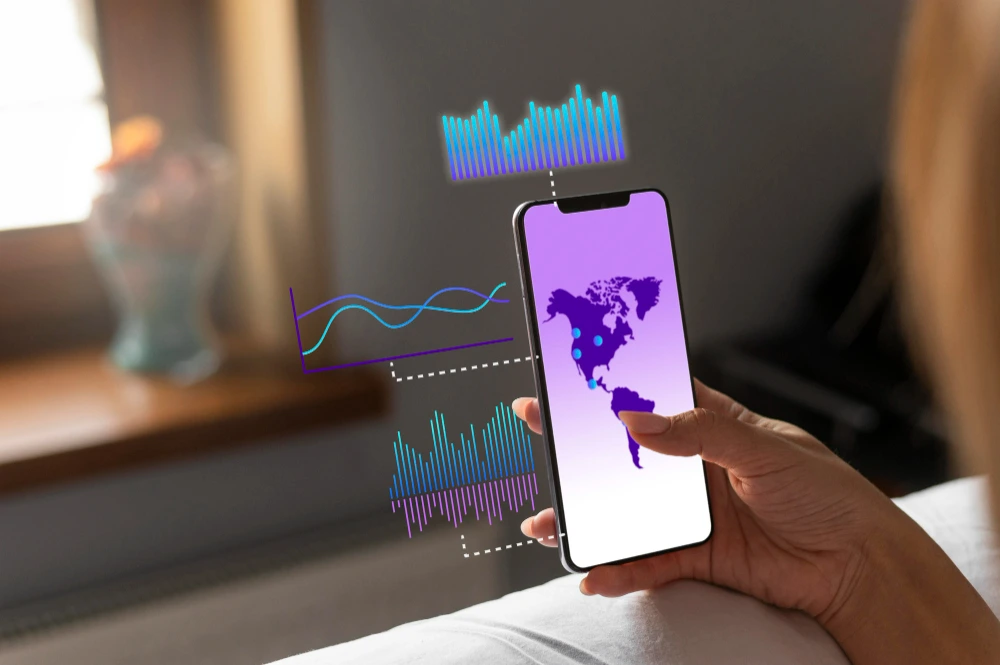
In today’s interconnected digital economy, mobile applications transcend borders faster than ever. A fitness app launched in the United States can attract users from Asia or the Middle East within weeks. Likewise, an e-commerce platform developed in Singapore may find its customer base expanding into Europe or Latin America.
Yet, designing a mobile app that performs seamlessly across regions is far from simple. Success in the cross-border mobile app landscape demands more than translating interfaces or changing color palettes. True global readiness comes from engineering adaptability into design, infrastructure, compliance, and user experience.
At axiusSoftware, we believe the future of mobile technology is borderless but locally intelligent, where every user, regardless of geography, experiences a product that feels built just for them. Achieving this balance requires foresight, cultural understanding, and deep technical and regulatory expertise.
Why Cross-Border Design Matters
Global Reach Requires Local Relevance
User behavior and expectations vary significantly between regions. A simple onboarding flow that delights users in the United States might feel too minimalistic in Japan or too intrusive in Germany.
Payment preferences, color psychology, and data consent practices all differ. Without localization, even the best-designed apps risk low adoption in new markets.
Data Privacy and Trust Are Non-Negotiable
Governments worldwide are enforcing stricter data privacy regulations. Non-compliance with local laws such as GDPR, PIPL, or CCPA can result in fines, reputational damage, or outright bans. Apps must therefore be designed with regulatory flexibility, allowing compliance modules to adapt by region.
Infrastructure Disparities Affect Experience
Network coverage, device types, and mobile usage patterns vary by country. An app optimized for 5G performance may struggle in regions with limited connectivity or lower-end smartphones. Cross-border readiness requires adaptive performance engineering, ensuring consistent speed and usability regardless of technical environment.
Designing for Cross-Border Usability and Technology
Expanding globally requires moving from a “translation-first” approach to a “technology-first adaptability model.” Here’s what that looks like.
Multi-Language Frameworks and Internationalization (i18n)
Localization is about translating text. Internationalization (i18n) is about engineering flexibility so an app can support multiple languages and cultural formats without breaking its logic.
Key practices include:
- Unicode support for all character sets including Latin, Cyrillic, Chinese, and Arabic.
- Right-to-left (RTL) layout support for languages such as Arabic or Hebrew.
- Dynamic text scaling for languages with variable word lengths.
- Externalized language files separate from core code for scalability.
- Automated localization testing for UI validation across languages.
Example: A U.S.-based food delivery app can expand to Japan or Saudi Arabia seamlessly if its codebase supports i18n. Without it, even a small UI update could require a full redesign.
Region-Specific Infrastructure and Performance Optimization
Performance expectations differ by geography. Apps must adapt to varying network bandwidths, device capabilities, and latency challenges.
Optimization strategies:
- API Efficiency: Reduce redundant requests and compress payloads for low-bandwidth users.
- Regional CDNs: Deploy data closer to users for faster load times.
- Offline-First Design: Ensure essential functions like browsing or booking work without internet access.
- Device Testing: Validate across both premium and entry-level smartphones.
- Multi-Cloud Deployment: Utilize global cloud providers such as AWS, Azure, Alibaba Cloud, and GCP to meet compliance and speed needs.
Example: A ride-hailing app that works flawlessly in New York must account for 3G/4G connections in Mumbai. Offline maps and cached trip histories improve user retention dramatically.
Payment Gateway Flexibility
Payment ecosystems vary across markets. Developers should implement modular payment frameworks that integrate easily with local gateways.
- North America and Europe: Credit cards, PayPal, Apple Pay, Google Pay.
- China: Alipay, WeChat Pay, UnionPay.
- India: UPI, Paytm, PhonePe.
- Middle East: Mada, STC Pay.
- Africa: M-Pesa, Airtel Money.
Solution: Use adapter-based architecture so that new payment methods can plug in regionally without rewriting code.
Example: An e-commerce app entering China must integrate WeChat Pay to be credible. Without it, user conversion drops significantly.
UX Flexibility Across Cultures
Cultural context defines usability. Design logic that works in one region may frustrate another.
Key UX considerations:
- Navigation hierarchies Differ by culture.
- Colors Convey different meanings (red = danger in the West, prosperity in China).
- Address and form formats Vary by country.
- Units, dates, and measurements Differ (kilograms vs. pounds, DD/MM/YYYY vs. MM/DD/YYYY).
Example: A fitness app must automatically detect locale and switch between kilograms or pounds to deliver a native experience.
Navigating Regulatory Landscapes
Expanding globally also means complying with regional laws and data policies. Non-compliance can lead to service restrictions, heavy fines, or user distrust.
Data Privacy Compliance
- Europe (GDPR): Explicit consent, right to be forgotten, and data portability.
- California (CCPA): Opt-out of data sale and transparency of data use.
- China (PIPL): Strict cross-border transfer rules and data residency mandates.
- Brazil (LGPD): GDPR-style user rights and consent requirements.
Technical solutions:
- End-to-end encryption: At rest and in transit.
- Regional data hosting: To ensure sovereignty.
- Consent management dashboards: With audit trails.
Cybersecurity Standards
Apps deployed globally are exposed to diverse cyber threats. Compliance with both global and local cybersecurity standards is crucial.
- Multi-factor authentication and session timeouts Enhance account security.
- Secure APIs Using OAuth2 and JWT.
- Localized encryption algorithms Such as China’s SM standards.
- Regular penetration testing and vulnerability assessments Ensure ongoing system security.
Industry-Specific Regulations
Sector-specific rules demand additional safeguards:
- Healthcare: HIPAA (US), GDPR (EU), National Health Regulations (China).
- Finance: PCI-DSS, local banking and anti-fraud compliance.
- Education: COPPA (US) for minors’ data protection.
Strategies for Cross-Border Success
Scaling globally requires strategy, discipline, and a robust technology foundation.
Modular Architecture
Monolithic apps often fail under international expansion. Modular or microservices-based architecture enables independent, adaptable components.
- Payment Modules: Integrate local gateways easily.
- Authentication Modules: Offer region-specific logins (WeChat, Google, Aadhaar).
- Compliance Modules: Deploy regional legal workflows seamlessly.
DevOps and Multi-Cloud Deployments
Global scalability demands automation and resilience.
- Continuous Integration and Continuous Deployment (CI/CD) pipelines streamline rollouts.
- Infrastructure as Code (IaC) tools such as Terraform enable fast replication across regions.
- Multi-cloud deployment reduces latency and ensures compliance.
Compliance by Design
Embedding compliance from the beginning is more sustainable than adding it later.
- Implement privacy-by-design and data minimization principles.
- Build regional consent mechanisms aligned with local laws.
- Maintain audit logs for data access and processing transparency.
Continuous Testing and Monitoring
Cross-border apps require continuous performance evaluation.
- Simulate devices and networks from multiple geographies.
- Automate localization and UI testing.
- Monitor performance metrics using APM tools.
- Use analytics to track engagement and drop-offs by region.
Hybrid Global-Local Model
Maintain a consistent global brand while tailoring regional experiences.
- Core security and design logic remain consistent.
- Local features (such as payment, navigation, or notifications) adapt regionally.
- Offer geo-targeted campaigns and localized promotions.
API-First and Integration-Ready Development
APIs make global scalability manageable.
- Centralized API gateway for governance and rate limits.
- Localized mapping and government APIs for compliance (e.g., using Baidu Maps in China).
- Independent microservices allow flexible feature updates.
Security and Fraud Prevention
Fraud risk rises with cross-border scale.
- AI-powered fraud detection for transaction monitoring.
- Adaptive authentication in high-risk regions.
- Adherence to global standards such as ISO 27001 and PCI-DSS.
Continuous Market Feedback and Iteration
Real-time insights help improve adoption.
- Conduct regional beta testing before full rollout.
- Use localized analytics and A/B testing to refine features.
- Collect user feedback via in-app surveys and regional support channels.
The Borderless Future of Mobile Applications
The next wave of mobile innovation will be global-first and locally adaptable. Businesses that fail to tailor experiences by region risk alienating users, violating local regulations, or being outperformed by regional competitors.
At axiusSoftware, we help organizations design and build cross-border mobile apps that combine global scalability with local intelligence. From multilingual frameworks and modular payment gateways to region-specific compliance and security solutions, we ensure your app not only scales internationally but also feels native everywhere it goes.
Because in today’s digital landscape, success is not about being everywhere — it is about being everywhere, the right way.
Frequently Asked Questions (FAQ)
Q. What makes cross-border mobile app development challenging?
Building apps for multiple countries requires aligning with varying languages, cultural behaviors, data protection laws, and payment systems. Developers must ensure technical adaptability and legal compliance across markets to avoid service restrictions or reputational damage.
Q. How can apps comply with multiple data privacy laws?
The best practice is to build compliance into the design phase. Use modular compliance layers, data encryption, user consent dashboards, and localized storage that meet regulations such as GDPR, CCPA, and PIPL.
Q. Why is performance optimization essential in cross-border apps?
Network speed, device quality, and bandwidth differ globally. Adapting APIs, caching content regionally, and using multi-cloud CDNs ensure consistent performance across all markets.
Q. How does axiusSoftware support cross-border app development?
axiusSoftware helps enterprises build and scale apps internationally through multi-language support, region-specific infrastructure design, compliance integration, and modular architecture. With experience in over 15 global markets, we understand how to align global strategy with local market realities.
Q. What industries benefit most from cross-border app strategies?
E-commerce, fintech, healthcare, and education benefit significantly. These sectors demand data compliance, payment localization, and user experience alignment across geographies — exactly where cross-border app strategies excel.







